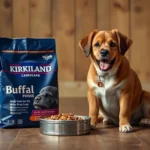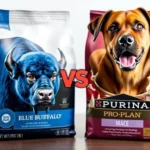
Introduction
Proper dog nutrition is essential for maintaining the health and well-being of our furry friends. Just like humans, dogs require a balanced diet to thrive, which includes a mix of macronutrients and micronutrients tailored to their life stage and individual needs. As dog owners, understanding the intricacies of dog nutrition can sometimes feel overwhelming. This is where dog food reviews come into play. They provide valuable insights that help us make informed decisions about what to feed our pets.
In this article, we will delve into the essentials of dog nutrition, explore different types of dog food available, and specifically review Answers Pet Food. We will discuss how to choose the right food for your dog, debunk common myths, and offer tips for transitioning to a new diet. By the end of this guide, you’ll have a comprehensive understanding of how to nourish your dog effectively.
Understanding Dog Nutrition
Basic Nutritional Needs
Dogs, like all animals, require a balance of macronutrients and micronutrients to support their health.
-
Proteins: Essential for growth, maintenance, and repair of tissues. Proteins are made up of amino acids, some of which are essential and must be obtained from food.
-
Fats: A significant energy source and crucial for healthy skin and coat. Omega-3 and omega-6 fatty acids are particularly important for maintaining overall health.
-
Carbohydrates: While dogs do not have a strict requirement for carbohydrates, they can be a good source of energy and fiber. Whole grains and vegetables can provide essential nutrients.
Additionally, micronutrients such as vitamins (A, D, E, K, and B-complex) and minerals (calcium, phosphorus, potassium) play vital roles in various bodily functions.
Life Stages and Nutritional Requirements
Dogs’ nutritional needs change at different life stages:
-
Puppies: Require higher protein and calorie content for growth and development. Specialized puppy formulas are designed to meet these needs.
-
Adults: Need a balanced diet that maintains their weight and energy levels. The focus should be on quality proteins and a moderate amount of fats.
-
Senior Dogs: Often require lower calories but higher fiber to aid digestion, along with joint support supplements.
Special Dietary Needs
Some dogs may have allergies or sensitivities to certain ingredients, necessitating a specialized diet. Conditions such as obesity, diabetes, or kidney disease may also require tailored nutritional approaches. Always consult with a veterinarian for personalized dietary advice.
Types of Dog Food
Dry Dog Food (Kibble)
Dry dog food or kibble is one of the most popular options.
-
Benefits: Convenient, cost-effective, and helps maintain dental health by reducing plaque buildup.
-
Drawbacks: Some kibbles may contain fillers or low-quality ingredients. It’s essential to choose high-quality brands that prioritize nutrition.
Recommended brands include:
– Orijen
– Wellness CORE
– Blue Buffalo
Wet Dog Food (Canned)
Wet dog food is another common option, often more palatable for dogs.
-
Advantages: Higher moisture content helps with hydration. It can be an excellent choice for picky eaters or dogs with dental issues.
-
Disadvantages: Generally more expensive than kibble and may have a shorter shelf life once opened.
Popular choices include:
– Merrick Grain-Free Wet Dog Food
– Hill’s Science Diet
– Royal Canin
Raw and Homemade Diets
Raw feeding involves feeding dogs raw meat, bones, fruits, and vegetables.
-
Benefits: Advocates claim that a raw diet can lead to healthier coats and improved digestion.
-
Risks: Potential for bacterial contamination and an unbalanced diet if not properly formulated.
For those interested in homemade dog food, basic recipes can include:
– Cooked lean meats (chicken, turkey, beef)
– Cooked vegetables (carrots, peas, spinach)
– Cooked grains (brown rice, quinoa)
Grain-Free vs. Grain-Inclusive Diets
The debate between grain-free and grain-inclusive diets has gained traction in recent years. Some argue that grains can lead to food allergies, while others maintain that grains provide essential nutrients and energy.
-
When to choose grain-free: If your dog shows signs of allergies or sensitivities to grains.
-
When to choose grain-inclusive: If your dog is healthy and has no dietary restrictions.
How to Choose the Right Dog Food
Reading Dog Food Labels
Understanding how to read dog food labels is crucial for making informed choices. Key components to focus on include:
-
Ingredients: Look for high-quality protein sources listed first. Avoid foods with vague terms like “meat by-products.”
-
Guaranteed Analysis: This section shows the minimum percentages of protein and fat and the maximum percentages of fiber and moisture.
-
Nutritional Adequacy: Ensure the food meets AAFCO standards, which indicate it provides complete and balanced nutrition.
Evaluating Dog Food Brands
When assessing different dog food brands, consider:
-
Reputation: Research the brand’s history and any recalls or controversies.
-
Ingredient Sourcing: Transparency about where ingredients are sourced can indicate quality.
-
Research and Development: Brands that invest in research and veterinary consultations are often more credible.
The Role of AAFCO and Nutritional Guidelines
The Association of American Feed Control Officials (AAFCO) sets standards for pet food labeling. Look for the AAFCO statement on the packaging, which ensures the food is formulated to meet the nutritional levels established by AAFCO.
Answers Dog Food Review
Overview of Answers Pet Food
Answers Pet Food is a company that focuses on providing high-quality, raw pet food options. Their mission is to create biologically appropriate diets that meet the needs of dogs and cats alike. They emphasize transparency and sustainability in their sourcing and manufacturing processes.
Ingredients and Nutritional Profile
Answers dog food products utilize high-quality ingredients sourced from trustworthy suppliers. Key components include:
- Raw meats: Sourced from pasture-raised animals.
- Fermented vegetables: Provide probiotics for digestive health.
- Healthy fats: Such as fish oil for omega fatty acids.
Their nutritional profile is designed to mimic a dog’s natural diet, offering a balance of proteins, fats, and essential nutrients.
Product Lines
Answers Pet Food offers several product lines, including:
- Raw: Freeze-dried and frozen raw options that maintain nutritional integrity.
- Fermented: Products that include fermented ingredients for gut health.
- Freeze-Dried: Convenient options that retain nutrients while being easy to serve.
Customer Reviews and Feedback
Customer reviews of Answers Pet Food generally highlight positive experiences. Many dog owners report improved health, better coats, and increased energy levels in their pets. However, some users have mentioned that the price point can be higher than traditional kibble.
Pros and Cons of Answers Dog Food
Pros:
– High-quality, natural ingredients.
– Emphasis on raw and minimally processed foods.
– Positive customer feedback regarding pet health.
Cons:
– Higher cost compared to conventional dog foods.
– Requires proper storage and handling of raw products to ensure safety.
Common Myths About Dog Nutrition
Grain-Free Diets are Best for All Dogs
The idea that every dog should be on a grain-free diet is misleading. While some dogs may benefit from it, many thrive on grains. Always assess your dog’s individual needs.
Dogs Can Eat Human Food
Not all human food is safe for dogs. Foods like chocolate, grapes, and onions can be toxic. Always consult with a vet before sharing your meals.
All Dog Food is Created Equal
Quality varies significantly among dog foods. It’s essential to choose a brand that prioritizes nutrition and quality ingredients.
Commercial Dog Food is Always Bad
While some commercial dog foods contain fillers and low-quality ingredients, many reputable brands offer high-quality options. Research is key to finding the right one.
Tips for Transitioning Dog Food
Gradual Transition Methods
When switching dog foods, it’s crucial to do so gradually. A common guideline is to follow a 7-10 day transition period:
- Start with 25% new food mixed with 75% old food for the first 2-3 days.
- Gradually increase the new food to 50% over the next several days.
- Continue increasing until you reach 100% new food.
Monitoring Your Dog During Transition
Watch for any signs of digestive upset or allergies, such as vomiting, diarrhea, or excessive scratching. If these occur, slow down the transition process and consult with your veterinarian if necessary.
Conclusion
In summary, understanding dog nutrition is vital for ensuring your pet leads a healthy and happy life. Making informed choices based on quality ingredients and proper dietary needs can significantly impact your dog’s well-being. Remember, dog food reviews can be an invaluable resource in your quest to find the best food for your furry friend. As you embark on this journey, keep researching and learning about the latest in pet nutrition to provide the best care possible for your canine companion.









